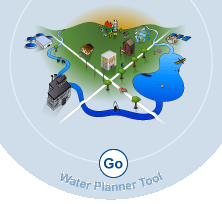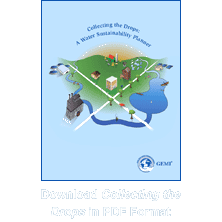
|
|
Collecting the Drops: A Water Sustainability PlannerReference Section
For water pricing, there are two broad categories of water availability: self-supplied and purchased. With regard to self-supplied water, permits and fees related to resource use and return may be applied. Contracts and agreements for volume of storage or flow entitlement, similar to U.S. water rights administration, may also be applicable. With respect to purchased water, in general, the principle of full direct cost recovery in establishing rates might be assumed. This is consistent with European Union (EU) Directives and World Bank Policies. An important consideration, often overlooked in past rate setting practice, is the capture of all costs. Development grants and loans as well as long-term contracts for water storage or availability at subsidized rates and low cost water rights systems can lead to setting rates too low ignoring long-term replacement and development costs. While economic theory for production may support pricing consistent with short-run costs, economic efficiency for investment and long-term capacity calls for pricing based on long-term costs (see Marginal below). Pricing for efficiency is becoming more broadly accepted. In addition, full costs for social and environmental impacts and necessary mitigation for sustainability could be included with direct costs for future rate setting, contracts and governmental agreements. Resource depletion and sustainability effects charges may also be expected to become more common in the future. The primary purpose of a rate structure is to generate revenue to cover utilities costs; however, rate structure may also be used to allocate costs among users and user groups and to provide incentives to customers to adopt beneficial water use patterns. Water rate setting can be a variable and complex process depending upon not only good asset management principles, but also rate of return and environmental costs. In addition, flat rates or service charges independent of quantity of water used are still encountered in some systems. Fire service, public use and building capacity are also built into some utility costs. Basic water rate structures include the following, sometimes in variation and combination:
The social/cultural/political setting for water management manifests itself through a variety of governance forms, regulations and regulating institutions. Water management for flow-related water uses such as flood control, hydropower, navigation, recreation, fish and wildlife are often different and separate from public, commercial, industrial and wastewater institutions. The sophistication and ability to manage interfaces between responsibilities for various water uses is greater and accomplished with more certainty in developed countries. These countries might also be expected to have quantity and quality environmental permitting regulations with well-functioning enforcement institutions. In developed countries, a trend toward Integrated Water Resource Management (IWRM) to manage total water resources on a regional or watershed basis is clear. However, the degree of centralization versus fragmentation of both government and private sector responsibilities is variable and affected by the existence and form of regulatory and enforcement institutions. In developing countries, enforcement capability and longevity of decisions may contribute to uncertainty and could be considered. Risk related to a social/cultural/political setting is generally surrounded by larger degrees of uncertainty than hydrologic risk and not easily subject to mathematical analysis. Yet the approach set forth in Module 2 relies on the experience of the user to subjectively estimate a probability to aid decision making. Therefore, it will be important in this process not to be either too optimistic or too pessimistic. Very sensitive factors with surrounding uncertainties could be identified in order to focus attention on methods to circumvent, reduce or apply appropriate solutions to high priority risks. The array of factors to which an estimated risk will be assigned can be assessed in order to:
In some cases, community awareness programs may be more effective when pressure on a watershed is derived from quality or quantity issues related to run-off, homeowner irrigation or other community impacts. The term sustainability, although widely used, is often not precisely defined. For purposes of this discussion, it is presumed to be a concept related to using water to meet present needs without sacrificing ability to meet future needs. It also means using renewable water sources in a way that minimizes long-term environmental, ecological and social effects. Risks to water availability and use can be calculated as probabilities related to the hydrologic cycle (frequency of floods and droughts) or technological reliability in making trade-off decisions to meet future needs. Uncertainty is a lack of sufficient information to calculate and assess probabilities and may often relate to institutional, governance and market conditions as well as environmental settings. The goal of risk analysis is to produce good planning and design for sustainable use of water and minimizing uncertainty of shortage. Demand for water, as opposed to “need,” is an economic term where cost and relevant pricing mechanisms are applied to available water, often restraining expressions of “need.” Water may be used in two ways:
|
|
Module 1: Water Use and Impacts | Module 2: Water Management Risk Assessment | Module 3: Case Examples and Links
Home | Preface | Acknowledgements | Introduction | Calculators | Reference
All Contents © GEMI Inc., All Rights Reserved.

